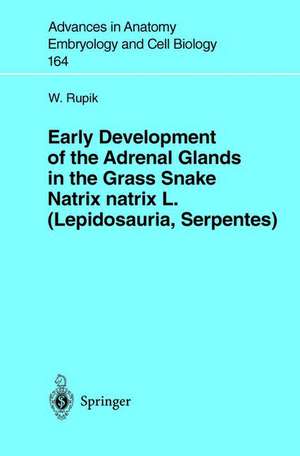Early Development of the Adrenal Glands in the Grass Snake Natrix natrix L. (Lepidosauria, Serpentes): Advances in Anatomy, Embryology and Cell Biology, cartea 164
Autor W. Rupiken Limba Engleză Paperback – 24 apr 2002
Din seria Advances in Anatomy, Embryology and Cell Biology
- 5%
 Preț: 1146.33 lei
Preț: 1146.33 lei - 5%
 Preț: 721.19 lei
Preț: 721.19 lei - 15%
 Preț: 637.13 lei
Preț: 637.13 lei -
 Preț: 381.81 lei
Preț: 381.81 lei - 15%
 Preț: 644.95 lei
Preț: 644.95 lei - 5%
 Preț: 1025.16 lei
Preț: 1025.16 lei - 15%
 Preț: 689.97 lei
Preț: 689.97 lei - 15%
 Preț: 577.07 lei
Preț: 577.07 lei - 15%
 Preț: 580.36 lei
Preț: 580.36 lei - 5%
 Preț: 393.51 lei
Preț: 393.51 lei -
 Preț: 408.66 lei
Preț: 408.66 lei -
![Die Schlüpfdrüse der Geburtshelferkröte (Alytes o. obstetricans [LAURENTI]) und anderer Froschlurche](https://i4.books-express.ro/bs/9783662239742/die-schluepfdruese-der-geburtshelferkroete-alytes-o-obstetricans-laurenti-und-anderer-froschlurche.jpg) Preț: 408.27 lei
Preț: 408.27 lei - 5%
 Preț: 1090.61 lei
Preț: 1090.61 lei - 5%
 Preț: 705.11 lei
Preț: 705.11 lei - 5%
 Preț: 706.04 lei
Preț: 706.04 lei - 5%
 Preț: 357.61 lei
Preț: 357.61 lei - 5%
 Preț: 704.59 lei
Preț: 704.59 lei - 5%
 Preț: 705.11 lei
Preț: 705.11 lei - 5%
 Preț: 359.42 lei
Preț: 359.42 lei - 5%
 Preț: 711.52 lei
Preț: 711.52 lei - 15%
 Preț: 635.47 lei
Preț: 635.47 lei - 15%
 Preț: 631.72 lei
Preț: 631.72 lei - 15%
 Preț: 633.35 lei
Preț: 633.35 lei - 15%
 Preț: 632.37 lei
Preț: 632.37 lei - 5%
 Preț: 706.60 lei
Preț: 706.60 lei - 15%
 Preț: 631.07 lei
Preț: 631.07 lei - 5%
 Preț: 707.13 lei
Preț: 707.13 lei - 5%
 Preț: 707.33 lei
Preț: 707.33 lei - 5%
 Preț: 359.60 lei
Preț: 359.60 lei - 5%
 Preț: 707.69 lei
Preț: 707.69 lei - 5%
 Preț: 707.13 lei
Preț: 707.13 lei - 5%
 Preț: 708.06 lei
Preț: 708.06 lei - 5%
 Preț: 706.41 lei
Preț: 706.41 lei - 5%
 Preț: 708.78 lei
Preț: 708.78 lei - 5%
 Preț: 705.68 lei
Preț: 705.68 lei - 5%
 Preț: 705.11 lei
Preț: 705.11 lei - 5%
 Preț: 706.77 lei
Preț: 706.77 lei - 15%
 Preț: 635.15 lei
Preț: 635.15 lei - 15%
 Preț: 631.07 lei
Preț: 631.07 lei - 5%
 Preț: 706.77 lei
Preț: 706.77 lei - 5%
 Preț: 706.04 lei
Preț: 706.04 lei - 5%
 Preț: 710.79 lei
Preț: 710.79 lei - 5%
 Preț: 705.32 lei
Preț: 705.32 lei - 15%
 Preț: 633.19 lei
Preț: 633.19 lei - 15%
 Preț: 629.09 lei
Preț: 629.09 lei - 15%
 Preț: 633.53 lei
Preț: 633.53 lei - 15%
 Preț: 632.70 lei
Preț: 632.70 lei - 15%
 Preț: 633.68 lei
Preț: 633.68 lei - 18%
 Preț: 773.72 lei
Preț: 773.72 lei - 15%
 Preț: 630.43 lei
Preț: 630.43 lei
Preț: 631.53 lei
Preț vechi: 742.98 lei
-15% Nou
Puncte Express: 947
Preț estimativ în valută:
120.84€ • 126.62$ • 99.90£
120.84€ • 126.62$ • 99.90£
Carte tipărită la comandă
Livrare economică 12-26 aprilie
Preluare comenzi: 021 569.72.76
Specificații
ISBN-13: 9783540431657
ISBN-10: 3540431659
Pagini: 116
Ilustrații: XI, 102 p. 92 illus., 2 illus. in color.
Dimensiuni: 155 x 235 x 6 mm
Greutate: 0.17 kg
Ediția:2002
Editura: Springer Berlin, Heidelberg
Colecția Springer
Seria Advances in Anatomy, Embryology and Cell Biology
Locul publicării:Berlin, Heidelberg, Germany
ISBN-10: 3540431659
Pagini: 116
Ilustrații: XI, 102 p. 92 illus., 2 illus. in color.
Dimensiuni: 155 x 235 x 6 mm
Greutate: 0.17 kg
Ediția:2002
Editura: Springer Berlin, Heidelberg
Colecția Springer
Seria Advances in Anatomy, Embryology and Cell Biology
Locul publicării:Berlin, Heidelberg, Germany
Public țintă
ResearchCuprins
1 Introduction.- 1.1 Comparative Morphology of Vertebrate Adrenals.- 1.2 History of Reptile Adrenal Studies.- 1.3 Nomenclature of Reptile Adrenal Glands.- 1.4 Adrenal Glands in Reptiles.- 1.5 Embryonic Development of Reptile Adrenals.- 1.6 Why Do We Study the Development and Differentiation of Adrenal Glands in Snakes?.- 2 Materials and Methods.- 2.1 Materials—Characteristic Features.- 2.2 Normal Developmental Table.- 2.3 Methods of Research.- 3 Results.- 3.1 Microscopic Anatomy of the Interrenal Tissue Primordium.- 3.2 Ultrastructure of the Interrenal Tissue Primordium.- 3.3 Microscopic Anatomy of the Chromaffin Tissue Primordium.- 3.4 Ultrastructure of the Chromaffin Tissue Primordium.- 3.5 Stages of Adrenal Development.- 4 Discussion.- 5 Conclusions.- 6 Summary.- References.
Textul de pe ultima copertă
Knowledge of the development and differentiation of adrenal glands in reptile embryos is fragmentary and inaccurate. Many contradictions and a lack of electron microscopical analysis of reptile adrenal primordia make it difficult to compare the gland development to other vertebrate groups. Insufficient knowledge allows us to only form hypotheses as to the differentiation of reptile adrenals, leading to certain generalisations on the evolutionary development of this organ in vertebrates. Thus, there are still many questions worth answering. To date, the genesis of interrenal tissues has not been clarified. The question of the moment of differentiation of two tissues remains open, as does that of their mutual topographic relationship during the development of adrenal glands in almost all reptile species. Furthermore, the time of the start of catecholamine synthesis in chromaffin tissue cells has not yet been defined. We also do not know when the adrenal cells in reptiles leave the embryonic stage and enter a full activity period. The reader will find answers to many of the above questions in the present volume.








